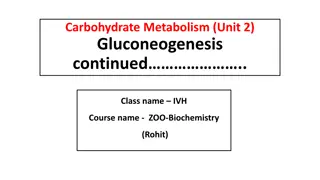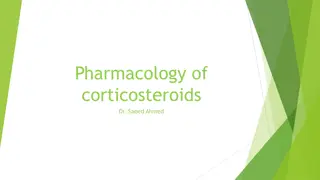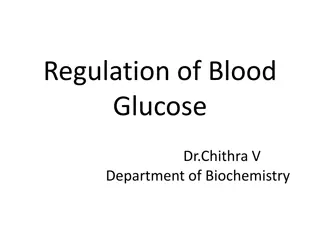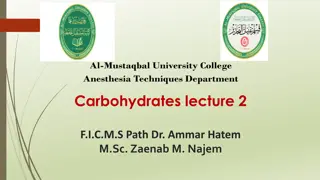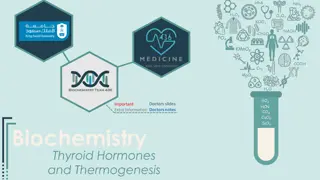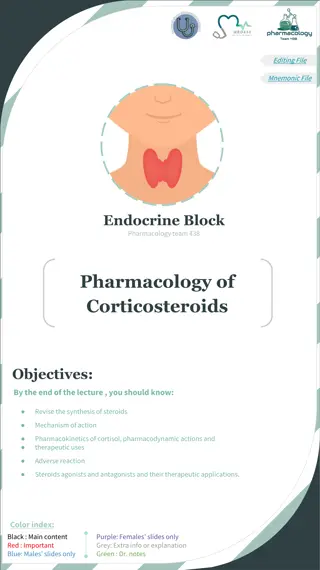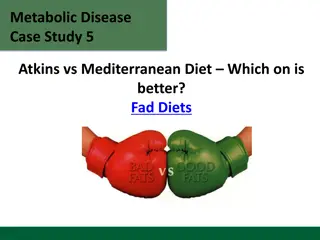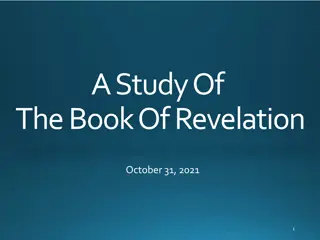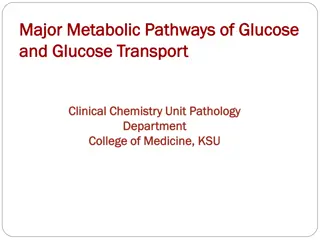
Understanding Gluconeogenesis: An In-Depth Overview
Explore the significance of gluconeogenesis as a vital pathway for glucose production, including its main reactions, rate-limiting enzymes, and substrates like glycerol, lactate, and pyruvate. Delve into the gluconeogenic pathway intricacies involving dephosphorylation, transport of oxaloacetate, carboxylation of pyruvate, and more. Discover the essential role of glucogenic amino acids and insights into the Cori Cycle.
Download Presentation

Please find below an Image/Link to download the presentation.
The content on the website is provided AS IS for your information and personal use only. It may not be sold, licensed, or shared on other websites without obtaining consent from the author. If you encounter any issues during the download, it is possible that the publisher has removed the file from their server.
You are allowed to download the files provided on this website for personal or commercial use, subject to the condition that they are used lawfully. All files are the property of their respective owners.
The content on the website is provided AS IS for your information and personal use only. It may not be sold, licensed, or shared on other websites without obtaining consent from the author.
E N D
Presentation Transcript
Glucose Metabolism: Glucose Metabolism: Gluconeogenesis Gluconeogenesis By Amr Amr S. S. Moustafa Moustafa, , MD, PhD Assistant Prof. & Consultant, Medical Biochemistry Assistant Prof. & Consultant, Medical Biochemistry Unit, Pathology Dept., College Pathology Dept., College of Medicine, KSU amrsm@ksu.edu.sa amrsm@ksu.edu.sa MD, PhD Unit, of Medicine, KSU
Objectives Objectives The importance of gluconeogenesis as an important pathway for glucose production The main reactions of gluconeogenesis The rate-limiting enzymes of gluconeogenesis Gluconeogensis is an energy-consuming, anabolic pathway
Gluconeogenesis: An Overview Gluconeogenesis: An Overview Liver (mainly) and Kidneys Both mitochondria and Cytosol Exception: Glycerol, only cytosol Gluconeogenic substrates: Glycerol Lactate and Pyruvate Glucogenic amino acids
Gluconeogenic Gluconeogenic Pathway Pathway Dephosphorylation of G-6-P Dephosphorylation of F 1,6-P Transport of OAA Carboxylation of pyruvate
Gluconeogenic Gluconeogenic Substrates: Glycerol Glycerol Substrates: *GK Glycerol Glycerol 3-phosphate ATP ADP NAD+ Glycerol 3-phosphate dehydrogenase NADH Glucose Dihydroxyacetone phosphate *GK: Glycerol kinase only in liver & kidneys
Glucogenic Amino Acids Glucogenic Amino Acids Asp Asn Amino acids Glu, Gln Phe Tyr Met Val
Gluconeogenic Gluconeogenic Substrates Substrates Lactate Gly, Ala Pyruvate Amino acids Asp Asn Glu, Gln Amino acids Phe Tyr Met Val
Gluconeogenic Gluconeogenic Substrates: Lactate Substrates: Lactate (Cori Cycle) (Cori Cycle)
Gluconeogenic Gluconeogenic Pathway Pathway Dephosphorylation of G-6-P Dephosphorylation of F 1,6-P Transport of OAA Carboxylation of pyruvate
Pruvate Carboxylase and PEP Pruvate Carboxylase and PEP- -CK CK Fasting: Acetyl CoA (From FAO)* *Fatty Acid Oxidation Pyruvate carboxylase + PEP-CK = Pyruvate kinase
Fructose 1,6 Fructose 1,6- -Bisphosphatase Bisphosphatase Fructose 1,6-bisphosphatase = PFK-1
Glucose 6 Glucose 6- -Phosphatase Phosphatase Glucose 6-phosphatase = Glucokinase
Gluconeogensis: Gluconeogensis: E E- - Consumed Consumed Six High-Energy Phosphate Bonds From Pyruvate to Glucose 2 ADP 2 ATP
Gluconeogenesis: Regulation Gluconeogenesis: Regulation Reciprocal control Gluconeogenesis & Glycolysis Allosteric: Acetyl CoA Pyruvate carboxylase AMP or ATP F 2,6-Bisphosphate Glucagon ( I/G ratio) Allosteric ( F 2,6-Bisphosphate) Induction (PEP-CK) + - + F 1,6-bisphosphatase -
Take Home Message Take Home Message Gluconeogenesis: Synthesis of glucose from noncarbohydrates Anabolic Energy-consuming 4 Unique enzymes are required for reversal of the 3 irreversible reactions of glycolysis Both gluconeogenesis & glycolysis are reciprocally-regulated


